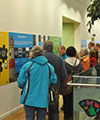March
Pupils produce new take on Tyneside history

A new take on the history of Tyneside icons including Newcastle United, Fenwick’s store and Souter Lighthouse are part of a special month-long exhibition at the Great North Museum: Hancock, and which has been researched and designed entirely by pupils at a Killingworth school.
Over the last four months, Year 7 students at George Stephenson High School have been researching a variety of topics, all with a connection to Killingworth and Tyneside, as part of their ‘Our Tyneside: place and people’ project.
Each of the nine classes has chosen a specific topic and carried out their own research, using a new online tool developed by Newcastle University, and funded by the Arts and Humanities Research Council, called Co-Curate North East. The website brings together materials from ‘official’ archives that relate to history of the North East, such as images, videos, sounds, stories, music, and animations, with those uploaded by community groups and individual researchers, from their own projects and collections. In this way, the website allows people to make and re-make stories by creating their own online exhibition which they can share with others.
The nine exhibits produced by the students all tell the histories of their community – from manufacturing and the diversity of products which were created on Tyneside, to the history of coal mining in the area, Tyneside traditions and a history of migration in Tyneside.
Dr Martyn Hudson, Project Manager of Co-Curate North East, said: “The pupils at George Stephenson High School have shown how digital technology can be used as a social memory machine - going beyond official archives to capture the personal connections with our communities that might otherwise be lost to history.
“The idea behind Co-Curate North East was to open up 'official' museum and 'un-official’ co-created community-based collections and archives through collaborations such as this one with George Stephenson High School, and it’s fantastic to see the end result of all the students’ hard work, creativity and commitment over the last few months.”
Teachers at the school saw the opportunity to use Co-Curate North East in place of the classroom-based museum project students have done in recent years. The Co-Curate project formed part of the students’ ‘iLearn’ lessons, in which they learn History, Geography and RE in an integrated way using a Project Based Learning approach, rather than as standalone subjects.
Phil Robinson, teacher at George Stephenson High School, said: “Having the chance to create an exhibition for a real audience, in a real museum, has been a great opportunity and I’m really proud of the way that the students have risen to the challenge.
“The project really opened their eyes to what goes in to putting an exhibition on at a museum. The students have done everything themselves: they chose the topics, and even applied for the various job roles within each team, such as curator, research historian, project manager and designer. They identified the areas they needed to research and then went off and did it. This has improved their ability to think about what they’re learning, how they approach tasks and how they deal with problems along the way. Throughout the process, the students have shown lots of resourcefulness, problem solving and grit in gathering the material they needed for the exhibition.”
In addition to using Co-Curate North East to research existing archives, students also sourced new material and uploaded this to the website – this included talking to members of their own community and creating their own images and video. They also proactively approached other archive sources such as Newcastle Libraries to get copyright permission to use images from their collections. On completion of their research, students submitted their draft design proposals to a professional graphic designer, who made their vision and ideas a reality.
Dr Katherine Lloyd, from Newcastle University, who worked with pupils on the project, explains: “The Co-Curate North East project is intended to be a living resource – something that can be shared and added to, to help tell the stories of the North East.
“The project has really benefitted from the students at George Stephenson High School identifying and sourcing new material as part of their project. For example, pupils uncovered pictures family members who worked in the mines and recorded oral histories with grandparents. This rich material will help us and future generations to gain a deeper understanding of the lives of people in the North East.”
published on: 2 March 2015
